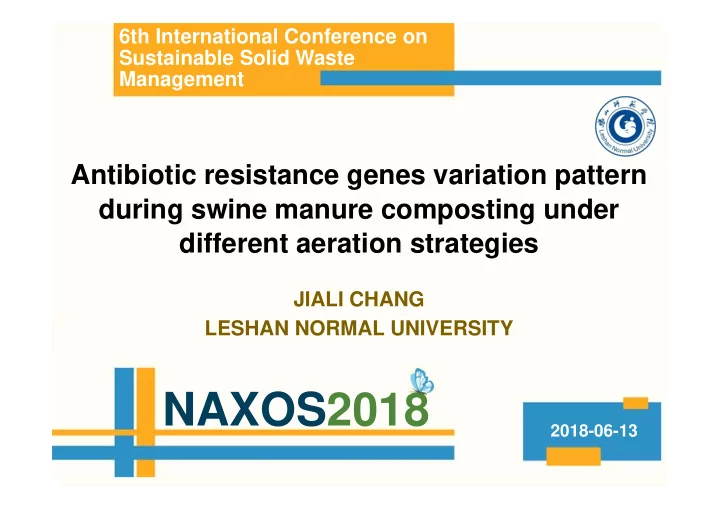

6th International Conference on Sustainable Solid Waste Management Antibiotic resistance genes variation pattern during swine manure composting under different aeration strategies JIALI CHANG LESHAN NORMAL UNIVERSITY NAXOS2018 2018-06-13
Background Antibiotics crisis Antibiotic resistance genes (ARGs) Emerging environmental contaminants (Jim O’Neill, 2016)
(Zhang Qianqian, et al., 2016) Background
Background Diverse, abundant, and potentially mobile ARGs in farm samples suggest that unmonitored use of antibiotics is causing the emergence and release of ARGs to the environment. (Zhu yongguan, et al., 2012)
Scientific problems Whether ARGs were eliminated or enriched after composting? How composting aeration methods influence the ARGs variation pattern?
Materials and methods Raw materials • Cornstalk air dried and chopped to ~ 5 -10 cm; • Pig faeces from Ganqingfen system of a local pig farm. Samples TOC TN Ammonium Moisture C/N (g·kg -1 ) (g·kg -1 ) (g·kg -1 ) content (%) Pig faeces 343.7 26.5 7.4 71.8 13.0 Cornstalk 419.0 9.9 — 9.3 42.3 Mixture 367.4 21.2 5.7 63.6 17.3
Materials and methods Composting methods • Materials were composted in 1.2 m 3 bins for 10 week. • Total 5 treatments: 1 5 Static, Turn, Forced aeration. • Turning frequency is 1/week. 2 4 • Aeration rate is 0.05/0.1/0.25 L·kgDM -1 ·min -1 . 3 1. Wooden boards with sampling holes; 2. Concrete side wall; 3. Concrete floor and aeration and leachate cavum; 4. Bottom board with aeration holes; 5. Compost materials.
Materials and methods Sampling for ARGs and microbial analysis tetW/tetO/tetH Aeration-0.05 Aeration-0.1 Aeration-0.25 Turn windrow Static pile Air suII/sulII 80 qnrS Temperature ( ℃ ) ermB 60 blaTEM intI 40 20 16S rRNA gene General bacteria 0 0 7 14 21 28 35 42 49 56 63 70 77 Composting time (d) Quantitative polymerase chain reaction (qPCR) Highthroughput sequencing via Illumina Miseq platform
blaTEM ermB tetW tetO qnrS tetH sulII sulI intI Static Turn Day 77 Aeration ‐ 0.05 Aeration ‐ 0.1 Aeration ‐ 0.25 Static Turn Day 49 Aeration ‐ 0.05 Aeration ‐ 0.1 Aeration ‐ 0.25 Static Turn Day 21 Aeration ‐ 0.05 Aeration ‐ 0.1 Aeration ‐ 0.25 Origin 80% 60% 40% 20% 100% 0% Relative abundances of each ARG Results_ ARGs Diversity patterns of whole composting the representative process among 5 different aeration ARGs during the methods
Static Day 77 ND Turn Aeration ‐ 0.05 Aeration ‐ 0.1 Aeration ‐ 0.25 ND Static Day 49 Turn Aeration ‐ 0.05 intI qnrS ermB Aeration ‐ 0.1 ND Aeration ‐ 0.25 Static Turn Day 21 Aeration ‐ 0.05 Aeration ‐ 0.1 ND Aeration ‐ 0.25 b d Origin f 1.0E+12 1.0E+10 1.0E+08 1.0E+06 1.0E+04 1.0E+12 1.0E+10 1.0E+08 1.0E+06 1.0E+04 1.0E+12 1.0E+10 1.0E+08 1.0E+06 1.0E+04 Static Day 77 Turn Aeration ‐ 0.05 Aeration ‐ 0.1 Aeration ‐ 0.25 tetW Static Day 49 Turn Aeration ‐ 0.05 sulII bla TEM Aeration ‐ 0.1 tetO Results_ ARGs Aeration ‐ 0.25 sulI Static tetH Day 21 Turn Aeration ‐ 0.05 Aeration ‐ 0.1 Aeration ‐ 0.25 a e Origin c 1.0E+12 1.0E+10 1.0E+08 1.0E+06 1.0E+04 1.0E+12 1.0E+10 1.0E+08 1.0E+06 1.0E+04 1.0E+12 1.0E+10 1.0E+08 1.0E+06 1.0E+04 ARGs copies per g dry compost
Results_ ARGs Removal rate of each ARG ‐ 350% ‐ 250% ‐ 150% ‐ 50% 50% 150% Aeration ‐ 0.25 Aeration ‐ 0.1 blaTEM Aeration ‐ 0.05 ermB qnrS Turn tetH Day 21/Thermophilic phase Static tetO tetW Aeration ‐ 0.25 sulI Aeration ‐ 0.1 sulII Aeration ‐ 0.05 intI Turn Static Day 77/Maturity phase
Results_ ARGs The heatmap of ARGs variation pattern during the whole composting process among 5 different aeration methods. Data were analyzed based on the ratio of absolute quantities of ARGs and 16S rRNA gene
Results_ Microbial community Phylum level Genus level
Results_ Network analysis Network analysis based on the co-occurrence of representative ARGs and their potential host bacteria. A connection represents a significant positive correlation ( P < 0.05) according to Spearman’s rank analysis. The blue and red lines were designated with negative and positive correlations, respectively.
Conclusion Composting was an efficient tool in terms of reducing most of ARGs in original swine manure, but sulfonamide resistance gene ( sulI/sulII ) and integrase gene (intI) were enriched instead of removal. The aeration methods showed little influence on the variation patterns of ARGs, especially the intractable stubborn ARGs like sulI/sulII/intI , innovative methods should be further developed for the elimination of these genes in compost. The enrichment of sulI/sulII/intI at the end of the composting was correlated with the increase of genera belonged to Actinobacteria, Proteobacteria and Bacteroidetes and the decrease of genera affiliated with Firmicutes.
LESHAN NAXOS
Recommend
More recommend